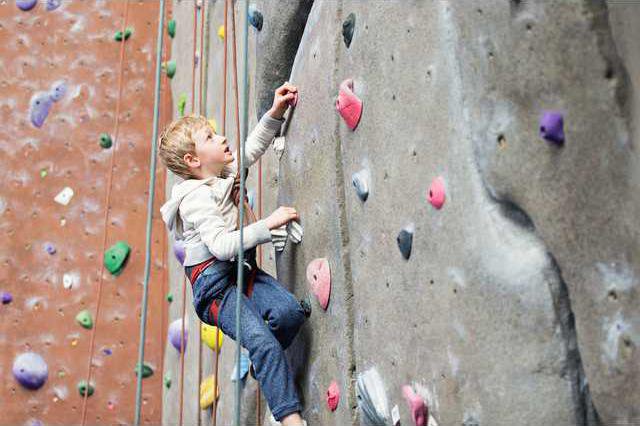Kids are natural climbers. They climb trees, fences and just about anything they can grab hold of.
Unlike adults, children do not have self-imposed limits and they have fewer preconceived notions about what their bodies can and cant do. With its skittle-colored handholds, an indoor climbing gym is the ideal jungle gym for kids.
Beyond the non-stop fun, indoor climbing offers kids valuable and lasting physical, mental and social benefits.
Physical
What makes climbing a unique physical activity is the multitude of movements that are utilized to ascend walls at different angles with a variety of holds. Instinctually, when a child learns to climb, he or she starts to discover their body mechanics as they build strength, increase balance, flexibility and power. This low-impact activity keeps kids burning energy while they rise to the challenge of pulling, pushing, twisting and stretching their body in a healthy way.
Mental
While most people think of climbing as purely physical, it actually requires a variety of mental abilities. Climbing can easily be compared to solving a vertical puzzle. It is an exercise in problem-solving and decision-making. A child must decipher the correct sequence of movements to link a particular set of holds in order to reach the top. This problem-solving aspect makes climbing a fun lesson for learning to create solutions to lifes future challenges.
In addition, climbing offers children an opportunity to learn long-term goal setting, which contrasts todays culture of instant gratification. To complete longer climbs, children must develop traits such as concentration, discipline, and focus traits that are easily transferable to school or later in the workplace. Its no accident that top-level climbers tend to be high achievers in life.
Lastly, climbing allows kids to move outside of their comfort zone in a controlled environment. When a child conquers one climbing challenge, there is another waiting, and they can learn something new from each one. Breaking through these barriers builds a childs confidence and teaches them to overcome fears in a productive way.
Social
While climbing is considered an individual sport, there are plenty of opportunities for one to develop communication skills, trust and friendship. Its common to see kids encouraging each other. Sharing climbs and solving challenges together allow young climbers to push each other constructively and build close friendships.
Although climbing can be casual and social, filled with physical or adventurous challenges, or provide a growth opportunity when pushing through mental barriers, the reality is most people climb because it is fun.
Unlike adults, children do not have self-imposed limits and they have fewer preconceived notions about what their bodies can and cant do. With its skittle-colored handholds, an indoor climbing gym is the ideal jungle gym for kids.
Beyond the non-stop fun, indoor climbing offers kids valuable and lasting physical, mental and social benefits.
Physical
What makes climbing a unique physical activity is the multitude of movements that are utilized to ascend walls at different angles with a variety of holds. Instinctually, when a child learns to climb, he or she starts to discover their body mechanics as they build strength, increase balance, flexibility and power. This low-impact activity keeps kids burning energy while they rise to the challenge of pulling, pushing, twisting and stretching their body in a healthy way.
Mental
While most people think of climbing as purely physical, it actually requires a variety of mental abilities. Climbing can easily be compared to solving a vertical puzzle. It is an exercise in problem-solving and decision-making. A child must decipher the correct sequence of movements to link a particular set of holds in order to reach the top. This problem-solving aspect makes climbing a fun lesson for learning to create solutions to lifes future challenges.
In addition, climbing offers children an opportunity to learn long-term goal setting, which contrasts todays culture of instant gratification. To complete longer climbs, children must develop traits such as concentration, discipline, and focus traits that are easily transferable to school or later in the workplace. Its no accident that top-level climbers tend to be high achievers in life.
Lastly, climbing allows kids to move outside of their comfort zone in a controlled environment. When a child conquers one climbing challenge, there is another waiting, and they can learn something new from each one. Breaking through these barriers builds a childs confidence and teaches them to overcome fears in a productive way.
Social
While climbing is considered an individual sport, there are plenty of opportunities for one to develop communication skills, trust and friendship. Its common to see kids encouraging each other. Sharing climbs and solving challenges together allow young climbers to push each other constructively and build close friendships.
Although climbing can be casual and social, filled with physical or adventurous challenges, or provide a growth opportunity when pushing through mental barriers, the reality is most people climb because it is fun.








